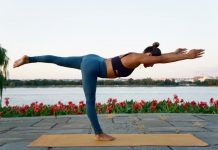A fascinating man by the name of Bellur Krishnamachar Sundararaja Iyengar, also known in the yoga community as B.K.S. Iyengar, developed, named, and perfected this unique form of yoga, which provides an emphasis on detail, precision and alignment focused on posture, and breathing techniques. It is a brilliant form of the yoga practice referred to as Hatha yoga, which emphasizes physical exercises that master the body along with mind exercises that help one to withdraw from outside, materialistic objects.
B.K.S. Iyengar
B.K.S. Iyengar was considered one of the greatest and well-renown yoga instructors in the world. His expertise on the practice led to him writing many books about the art of yoga and philosophy including ‘Light On Yoga’, ‘Light On Life’, and ‘Light On the Yoga Sutras of Patanjali’. His yoga master was Tirumalai Krishnamacharya, who is commonly referred to as “the father of modern yoga,” and was one of his earliest students. Iyengar is credited with popularizing yoga, first in India, and then around the entire world. He was given many awards for his practices and in 2004, about 10 years before his death, was named one of Time Magazine’s top 100 most influential people in the world.
Iyengar was the 11th of 13 children and faced losing his father at just 9 years old. His home town, Bellur, was in the midst of the influenza pandemic during the time of his birth. An attack of that disease left him sick and weakly at a very young age for several years. Through his childhood, he struggled with many other illnesses ranging from general malnutrition to malaria to tuberculosis. When he was older, he described his childhood self as scarily thin and spindly and said that his stomach stuck out in an unhealthy way.
In 1934, Iyengar’s brother-in-law asked him to come to Mysore, in order to improve his health through the practice of yoga. Iyengar was 15 years old at the time. There, he learned breathing practices which, almost instantaneously, improved his overall health. When his teacher, Tirumalai, had Iyengar and a few other students give a yoga demonstration, it left a positive affect on Iyengar, which he considered to be the turning point in his life. In 1937 he was sent to Pune at the age of 18 for the sole purpose of spreading the teaching of yoga.
A hugely notable point in the yoga teacher’s life came about in the year 1952, when Iyengar befriended the violinist known as Yehudi Menuhin, who gave Iyengar his big break and took him from an obscure Indian yoga teacher, to an international guru. Menuhin was known to be interested in the practice of yoga, and asked Iyengar to come to Bombay and meet with him. Immediately upon meeting, Menuhin told Iyengar that he was extremely tired and could only spare about five minutes with him. Iyengar accepted the challenge and had the violinist lay on his back in such a position that he fell asleep immediately and did not wake for about an hour. He woke up revitalized and spent the next two hours with Iyengar, later swearing that the practice of yoga helped to not only improve his overall health, but his violin playing as well. After another visit with Menuhin in Switzerland, Iyengar went on to visit the west regularly and schools teaching his form of yoga began to pop up all over the world.
In his later years, Iyengar displayed a loving support of nature conservation. He proposed that it was very important to conserve all animals and birds and donated a large sum of money to a zoo in India. His most important, charitable project however, involved donations to his hometown in Bellur. Through a trust fund that he established there, he transformed the village and served a plethora of charitable activities there. He built a hospital, a nonprofit school that supplies uniforms, hot lunch, and books to the children of Bellur and villages that surround it, as well as a secondary school, and a college.
Bringing Yoga Together
Iyengar systematically brought together more than 200 different classic yoga poses, as well as 14 different types of breathing techniques, with their subsequent variations. All of the moves are perfectly categorized from beginner level to advanced. This ensures the steady progression of students gradually moving from simple poses to more complex ones, and overall helps to develop their body, mind, and spirit in a step-by-step approach.
This form of yoga also incorporates the use of props such as blocks, belts, and blankets, which aid students in performing many different types and levels of posture. Certain props can better aid different types of people to perform the correct posture that suits them, and can help to minimize risk of injury or strain. Various props can help anyone on any level of yoga, from young to old in age. Unlike most average yoga classes where students are expected to independently “find their way” to correct posture by imitating whatever the teacher does, Iyengar yoga classes are highly verbal and precise, with incorrect alignments and errors actively perfected on the spot.
The practice of Iyengar yoga is believed to be an extremely powerful tool to relieve the stresses of everyday, modern life and in turn, helps to promote complete physical and spiritual well-being, according to many practitioners. It is characterized by paying great attention to detail and precise focus on the alignment of one’s body. It takes at least two years of rigorous training just for an aspiring Iyengar teacher to be granted their introductory certificate, where they then continue learning subsequent intermediate levels and then senior levels of certification, which typically entails over a decade of training.
How It Is Different?
Iyengar yoga can be distinguished from other styles of yoga by its three key elements: sequence, technique, and timing. Sequence refers to the sequences in which posture and breathing practices are exercised, as following the specific correctly modified sequence makes all the difference in one achieving their desired results – the right combination of poses and breathing techniques can and will result in the desired positive effect. Technique refers to the careful precision of the body’s alignment and the performance of one’s breathing techniques. And finally, timing, the third key element, refers to the amount of time one should spend on each pose.
Sadly, B.K.S. Iyengar passed away at the age of 95 in the year 2014. It is said that he died of renal failure as well as heart failure. He was cremated the same day of his death in an auditorium near his home. On December 14th of 2015, what would have been his 97th birthday, he was honored with a Google Doodle which is a temporary alteration of their logo on their website, which is intended to celebrate achievements, holidays, events, and people. The Oxford dictionary now even recognizes ‘Iyengar’ as a noun that describes the Hatha-type-yoga, which focuses on correctly aligning the body with the use of blocks, straps, and other objects as a means to achieve the correct posture. You can attend one of the hundreds of schools throughout the world that teach the astounding practice of Iyengar yoga. Rest in peace to the man that came from a near-death condition and transformed his life to not only benefit his health, but that of many others.
47 Most Famous Motivational Quotes of All-Time
49 Greatest Love Quotes
37 Inspirational Quotes that Will Change Your Life






























